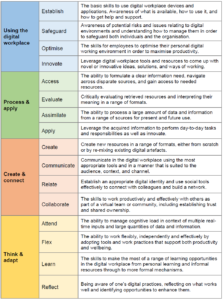New Voices RGU Student Series: Nisa Kamaruzaman
Category: New Voices
This blog is posted as part of our New Voices RGU Student Series, where we are publishing blogs written by Robert Gordon University Information and Library Studies Students as part of their coursework.
About the writer: Khairun Nisah Kamaruzaman is the former Deputy Director of the Library for the University of Kurdistan Hewlêr, Iraq, where she specialised in reader services. Her previous consulting experience in industry blended her business acumen and understanding of the importance of knowledge management in the private sector.
 Where do information professionals fit in the whole Digital Literacy (DL) adoption in the workplace
Where do information professionals fit in the whole Digital Literacy (DL) adoption in the workplace
In today’s information economy, the role of information professionals goes beyond the field of librarianship and knowledge management. As the world has become more digital the ability to seek, evaluate, use and disseminate information through digital channels becomes more critical. There is a need for Digital Literacy (DL) to be addressed at all levels. Information professionals play a vital role in shaping the society with digital skills and competencies. According to Krisha (Krisha 2019) “knowledge workers spend almost 30% of their time searching for information. Most of that time is wasted as workers don’t find what they’re looking for and give up, making decisions based on anecdotal information or intuition.” This shows the critical need for improvement in DL skills among the workforce.
In the workplace context, we will explore the definition and framework introduced by Marsh (Marsh 2018) which evolved from a number of models from earlier research done in this area (for further reading on the evolution of digital literacy definitions, refer to the appendix). “The framework aims to help organisations develop the understanding, assess current capabilities and underpin design of approaches to digitally upskill the workforce.” The four overarching skills areas are identified in Figure 1.
The framework then is further segmented into sixteen sub-facets which describe specific areas of skills such as staying safe online, evaluating information, building relationships, and continuous learning (Figure 2).
Why is DL so important in today’s workplace? And why is it harder to be competent in this area?

Figure 2 – Four skills area and sixteen sub-facets of Digital Workplace Skills Framework (Marsh 2018)
In the context of the workplace, DL is considered as valuable to any organisation, however the skills associated with DL are embedded within the context of business functionalities as argued by Cheuk (2017, p.131) and exist as part and parcel of skills required to perform the job. Without context, it is harder to provide the skills training to the employee.
As the ‘born digital’ generation are beginning to join the workforce there is a conundrum that information is available almost at a click of a mouse. However, one could end up with an ‘information overload’ situation. As highlighted (Hunter 2018) in a study on DL in the legal sector, most entry-level staff are demographically part of the ‘Google Generation’ which demonstrate lack of depth in information searching, unable to critically assess the result found and who rely heavily on the search engine ability to get them the right information.
How do information professionals become the beacon of DL in the workplace?
Being digitally competent is a lot harder than it seems, there needs to be a change agent within the workplace, someone who could provide a practical guide to DL across all levels with different information needs and ‘digital skills’. Information professionals could fill this ‘void’ due to our unique position where, while we are not professionally trained for the field e.g. medical, legal, engineering, architect etc., we are trained and equipped with the skills to find the information required for the field professionals to perform their tasks. Specialised librarians and information managers are key assets to their organisations. This is described by (Lloyd 2017 p. 111) who states that ‘librarians developed a resonance with the workplace and view their role not as a pusher of information but as translators’, mediators, sources of knowledge and collaborators’.
Knowing the information professional’s role towards facilitating DL is not enough, there needs to be a workable implementation model that can be adopted to facilitate the DL learning process across the board. One such model is the ‘Workplace Experience Framework’ introduced by Dr. Marc Forster where he focused on information needs behaviors in professional roles, from junior to senior level. An employee started with being a passive receiver of information i.e. receiving instructions towards being a strategic thinker and as they increase in seniority they developed their expertise. Then the learning plan is tailored to the specific needs of the role and career progression (Forster 2017). The framework was implemented on a group of nurses. The same framework was adopted by (Hunter 2018) in his setting i.e. a legal firm. Hunter used a proactive and radical approach as an active DL advocate in his organisation.
Some key initiatives include:
- Start them early – focus on the junior staff and teach them ‘advanced Google techniques’
- Embedding short DL skills training into an existing team meeting
- Collaborate with external trainers to conduct skills-based training and market it as ‘market update seminars’
DL is a necessity in the workplace and information professionals need to be proactive in fostering DL throughout the organisation.
References
CHEUK, B., 2017. The ‘hidden’ value of Information Literacy in the workplace context: how to unlock and create value. In: M. FORSTER, ed. Information literacy in the workplace. First ed. Croydon: Facet Publishing. pp. 131
FORSTER, M., 2017. Information literacy in the workplace. London: Facet Publishing.
HUNTER, I., 2018. Digital literacy in the workplace: A view from the legal sector. Business Information Review, 35(2), pp. 56-59
KRISHA, P., 2019. Enterprise search in 2020 and beyond: 5 trends to watch. [online] San Diego, California: Tabor Communications Inc. Available from: https://www.datanami.com/2019/08/23/enterprise-search-in-2020-and-beyond-5-trends-to-watch/ [Accessed 30 November 2019]
LLOYD, A., 2017. Learning within for beyond: exploring a workplace Informtion Literacy design. In: M. FORSTER, ed. Information literacy in the workplace. First ed. Croydon: Facet Publishing. pp. 111
MARSH, E., 2018. The Digital Workplace Skills Framework: Ensuring the workforce is ready to work digitally. Online: Digital Work Research 2018.
Appendix 1 – Further reading on DL models
https://ec.europa.eu/digital-single-market/en/news/ict-work-digital-skills-workplace
http://en.copian.ca/library/research/digi_es_can_workplace/digi_es_can_workplace.pdf
https://www.jisc.ac.uk/rd/projects/building-digital-capability
https://www.jisc.ac.uk/guides/developing-organisational-approaches-to-digital-capability
http://bonniecheuk.blogspot.com/
https://literacy.ala.org/digital-literacy/
https://theblog.adobe.com/how-digital-literacy-affects-the-modern-workforce/
http://www.hci.org/blog/got-skills-digital-literacy-close-workplace-knowledge-competency-gaps
https://www.technewsworld.com/story/86075.html
**The views expressed in our guest blogs are the writer’s and do not necessarily reflect the views of CILIPS**
